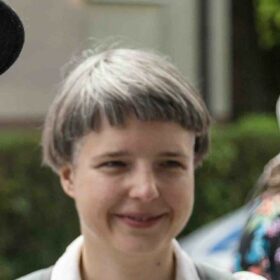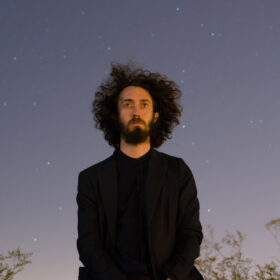Esther’s Willow is a collaboration between artists Katarzyna and Marta Sala and Robert Yerachmiel Sniderman for Chrzanów (PL), a half-Jewish city until the Nazi genocide and postwar processes that continued a long century of ethnic cleansing.
The artists have engaged with local and regional institutions, cultural workers, residents, and Jewish descendants and survivors of Chrzanów to re-plant a white willow sapling in the former Esther’s Square.
Esther’s Square, named as such in the 1920s, had been a locus of Jewish institutional life, and site of the Great Synagogue of Chrzanów until its sudden demolition by people in power in 1973, despite the organizing of Jews and other local cultural workers to repair it. The Sala family had rented an apartment on the now unnamed square for three generations. In 2018, Marta witnessed the cutting down of a white willow tree that had towered over the synagogue’s concealed foundations for as long as she could remember. After this, the artists began to think of the willow as having mourned the city’s destruction on its own living, nonhuman terms; a powerful utterance both to the gravestone-like plaque marking the site of the synagogue and a nearby oak tree, planted the same year the willow was cut, marking 100 years of Polish independence.
The sisters’ collaboration with Sniderman, whose ancestors fled Rzeszów and Jarosław, is born from and meant to contribute to the memory conditions of everyday life in a minor city.
During the COVID-19 pandemic, through experimental video correspondence, public meetings, walks, interviews, workshops, and the slow envisioning of the living memorial and a happening to plant it, the artists grappled to understand a potential rationale and lineage underneath their planting action. They eventually arrived at traditional cultural-medicinal uses and cosmological significance of the white willow across time, space, and peoples as an ethical-aesthetic guide.
The project’s approach then gestures into the city’s traumatic recent past to reach an old and intimate space of transcultural ancestral experience, where Jewish and Slavic communities in Poland mutually, collaboratively, and differently depended on willows to treat viruses, diseases, infertility, chronic pain, and other conditions more often specific to the bodies of women and children, exchanging knowledge, treatments, practitioners, and patients at a site of nonhuman mourning and visionary power that continues, even nominally (“weeping willow”), to mediate between the living and the dead. Here, through the weak resistance of the willow, the whole population of Chrzanów in time remains equally implicated in the work of feeling.
In an early workshop for Esther’s Willow, Wojciech Sala — Katarzyna and Marta’s beloved late father and lifelong resident on the former Esther’s Square — advocated for a way to extend the project’s intention beyond the singular happening, posing the question, “What stays there?” Since the planting of Esther’s Willow, the artists and their partners in Chrzanów and Kraków continue to work together, maintaining and forming relationships rooted in the project, and creating future happenings, public markers, a book and a film.
List of publications on Esther’s Willow:
- “A Willow (Grave) That Knows a Felled Willow (Mourner) That Knew an Eradicated Square (Woman)” by Robert Yerachmiel Sniderman (The Hopkins Review, 2023);
- “Planting Esther’s Willow” (Baltischer Limmud, 15/02/23);
- “Comemoração verde e prática não-invasiva – o caso de ‘O Salgueiro da Ester'” (Green commemoration and non-invasive practice – the case of “Esther’s Willow”) by Cheong Kin Man (Buala, 18/07/23);
- 波蘭的綠色紀念——種一棵樹的意義 (Green Memorial in Poland – The Meaning of Planting a Tree) by Cheong Kin Man (The New Lens, 15/7/23);
- 再遊波蘭小鎮山樂乎有感 (Visiting the Polish Town of Chrzanów Again) by Cheong Kin Man (Fantasia Macau, 30/5/23);
- “Drzewa zamiast pomników. Czym jest ‘zielone upamiętnienie’?” (Trees instead of monuments. What is a “green commemoration”?) by Jutyna Nowicka (Radio Kraków, 2/8/23);
- 以斯帖的柳樹——在波蘭小鎮植一棵樹 (Esther’s Willow – Planting a Tree in a Portland Town) by Cheong Kin Man (The New Lens, 3/9/22);
- 以斯帖的柳樹 (Esther’s Willow) by Cheong Kin Man (Fantasia Macau, 24/8/22);
- “O Salgueiro da Ester” (Esther’s Willow) by Cheong Kin Man (Jornal Tribuna de Macau, 20/7/22);
- “Le saule d’Esther” (Esther’s Willow) by Cheong Kin Man (Buala, 22/9/22);
- “Na dawnym placu Estery posadzono symboliczną wierzbę” (A symbolic willow tree was planted in the former Esther Square) (Chrzanowska Telewizja Lokalna, 4/7/22);
- “94-letni Abraham Wasserteil zapłakał nad Wierzbą Estery w Chrzanowie” (94-year-old Abraham Wasserteil wept over Esther’s Willow Willow in Chrzanów) by Łukasz Dulowski (Przełom Tygodnik Ziemi Chrzanowskiej, 30/7/22);
- Zaproszenie na Festivalt w Chrzanowie (Invitation to Festivalt in Chrzanow) (Chrzanowska Telewizja Lokalna, 30/6/22);
- 澳視覺人類學者歐洲展成果 (Macau visual anthropologist presents works in Europe) Macao Daily News, 9th July 2022;
- “Criar raízes culturais” (Creating cultural roots) (Hoje Macau, 4th July 2022);
- Macau visual anthropologist presents artwork in collaboration with Polish artist in Europe (The Macau Post Daily, 7th July 2022).
-
26 June 2115:00
Ester’s Willow. History and future of a willow from Chrzanów
Read more -
19 February 2217:00
Lecture “The Willow in Jewish Culture and at the Border of Cultures” by Dr Tuszewicki
Read more -
20 February 2214:00
Collecting individual stories for the “Esther’s Willow” project
Read more -
29 June 2219:00
“Esther’s Willow” Sala / Sniderman / Sala – exhibition
Read more -
03 July 2211:00
“Esther’s Willow” Sala / Sniderman / Sala – happening
Read more













